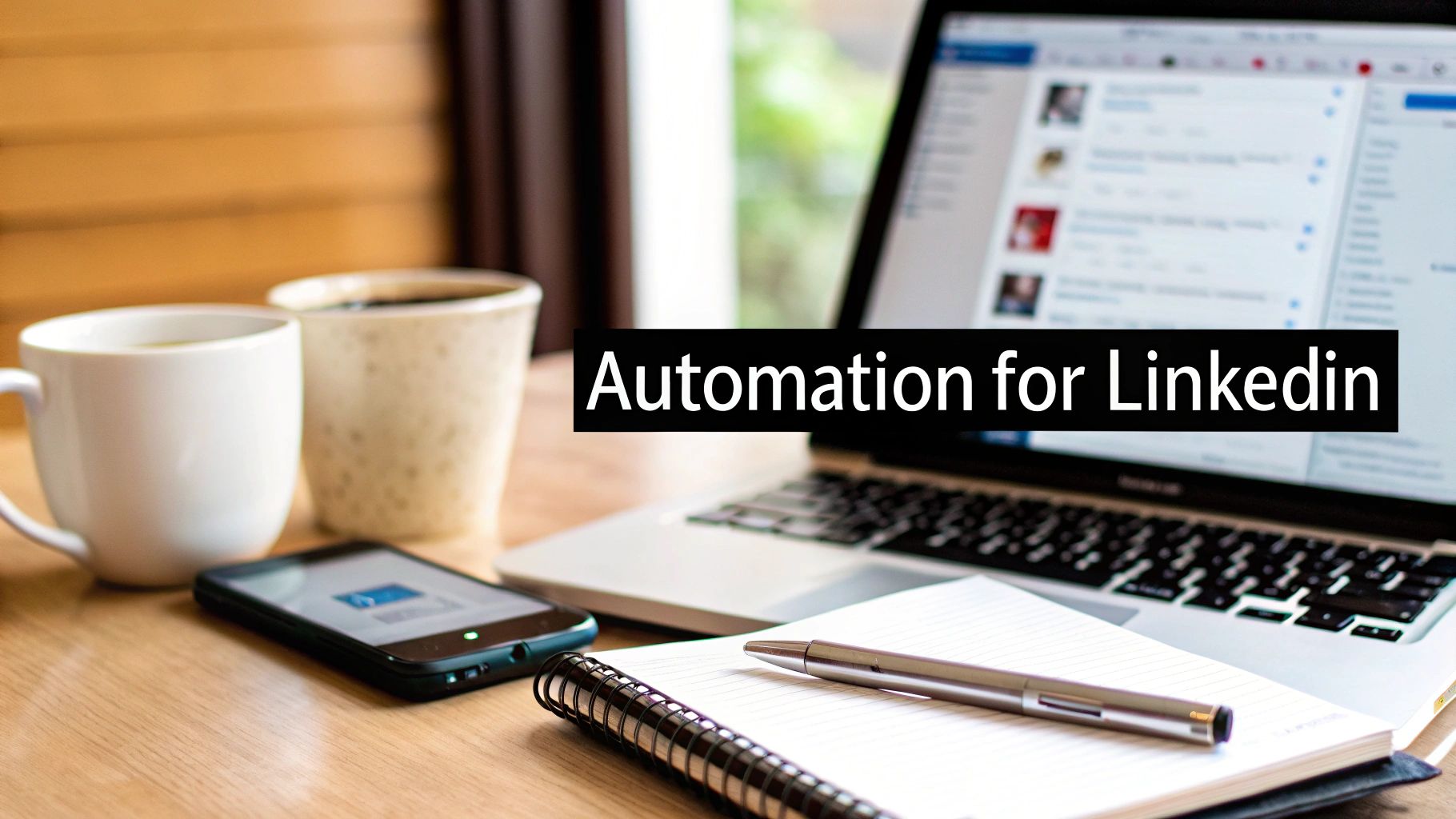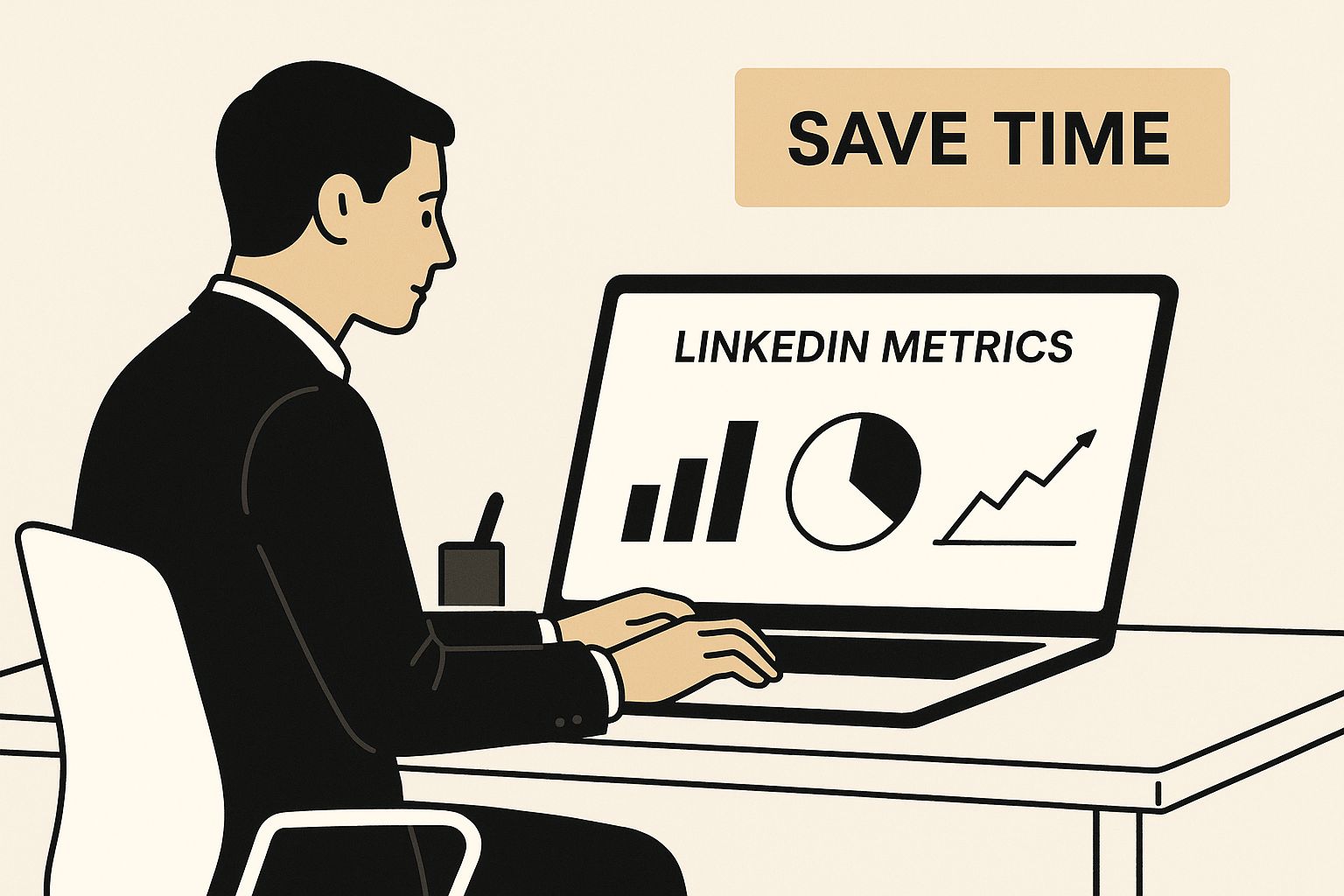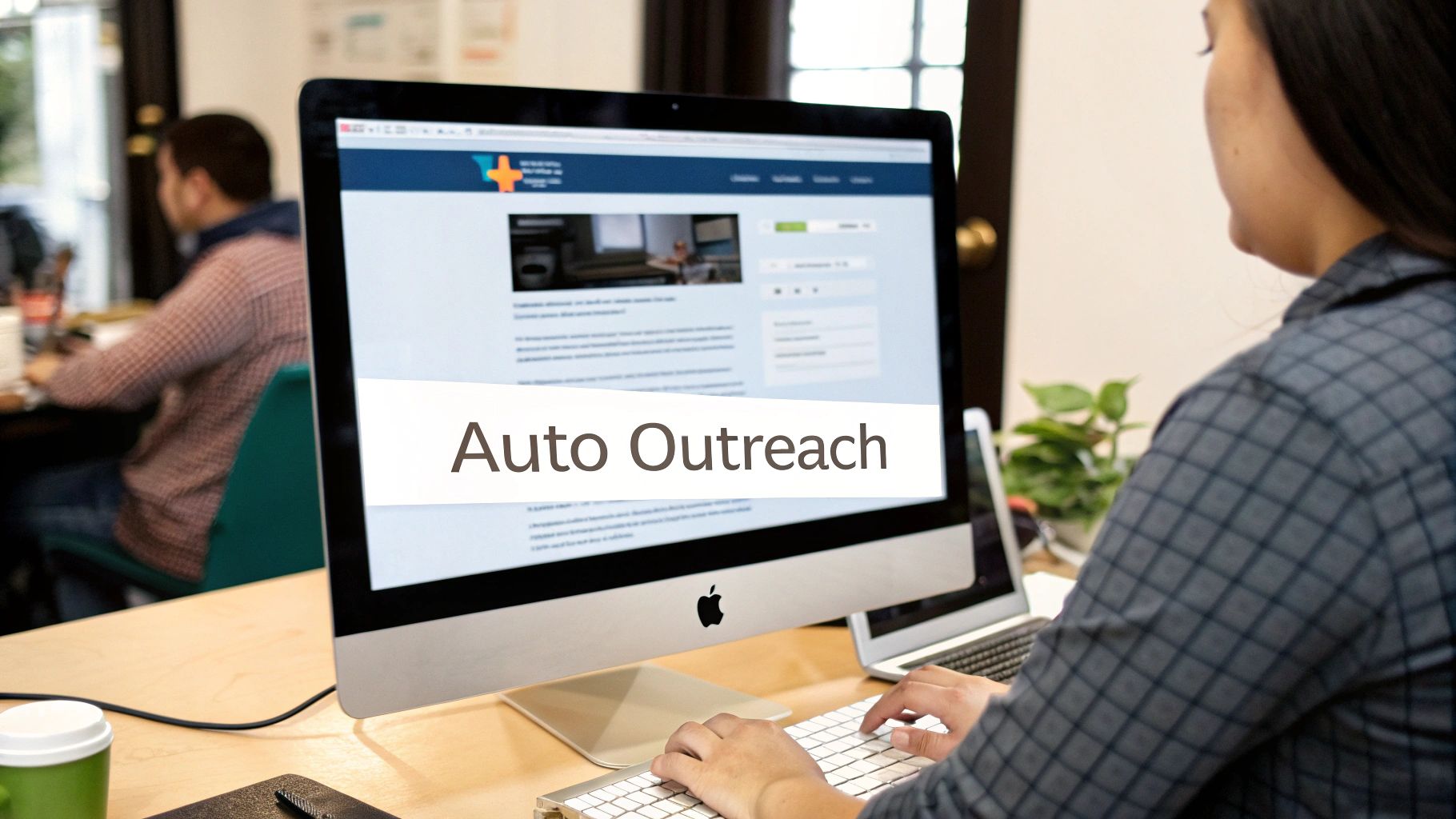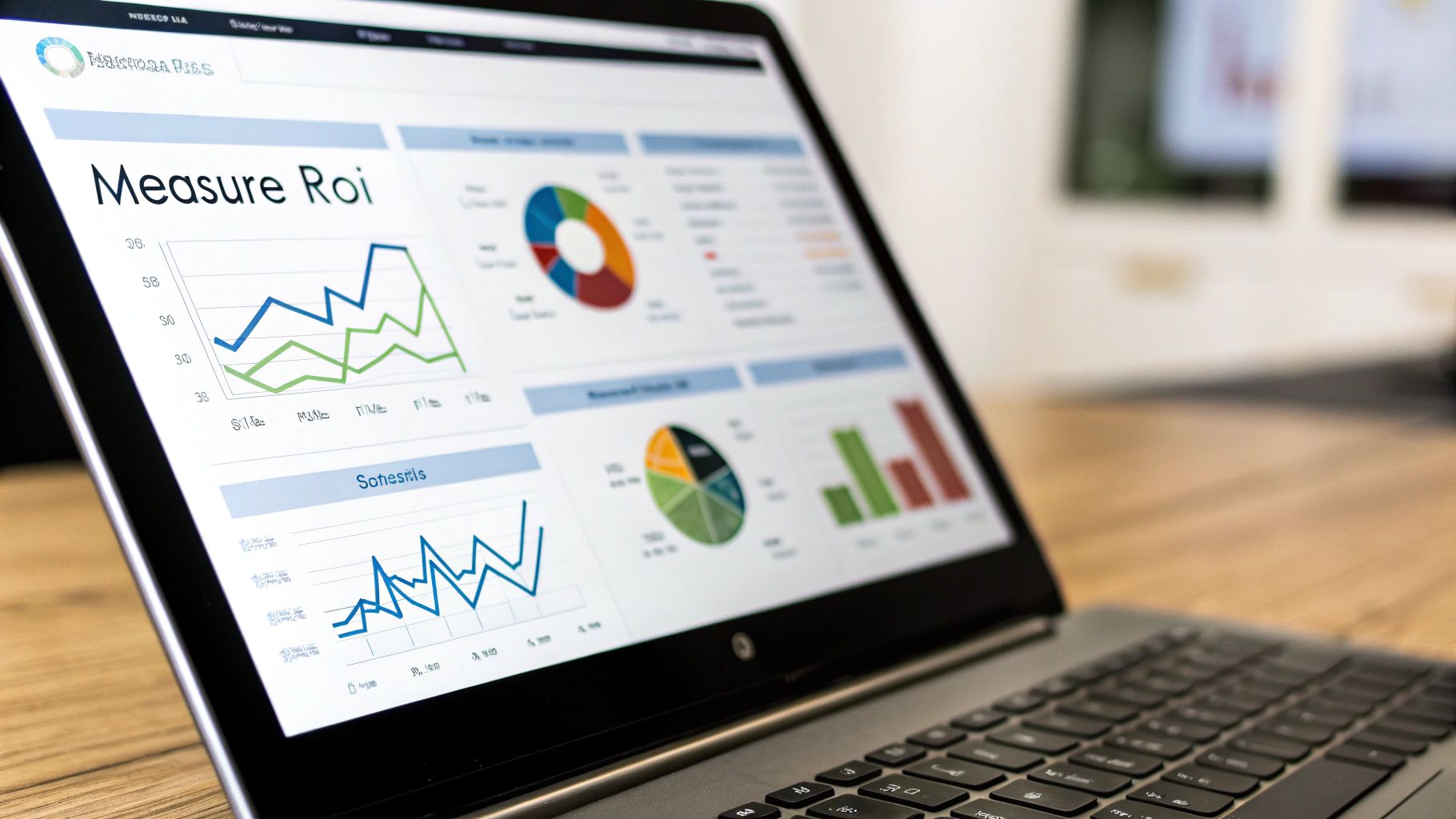
Automation for LinkedIn: Real Strategies That Work
Published on 2025-06-12
Why Smart Professionals Are Embracing LinkedIn Automation
Let's be real, manually connecting with hundreds of prospects while juggling everything else is just not feasible anymore. The networking game has evolved, and trying to keep up without a little help is exhausting. I've been chatting with tons of sales professionals lately, and the top performers are all doing the same thing: they're automating their LinkedIn activity. They're not replacing genuine interaction; they’re just making more space for it.
Think about it: you wouldn't hand-write emails to everyone on your mailing list. You’d use an email marketing platform like Mailchimp or Constant Contact. LinkedIn automation is the same principle applied to networking. It streamlines those initial steps, freeing you up for the important conversations. I know a consultant who used to struggle to make five meaningful connections a week. He started using LinkedIn automation and is now having 50 qualified conversations a month. That's huge!
Besides, LinkedIn has millions of professionals. Building a network requires consistent engagement, and doing that by hand is an uphill battle. Automation helps you stay top-of-mind by scheduling posts, endorsing skills, and even sending personalized messages at scale. It's like having a virtual assistant dedicated to your LinkedIn profile. The result? More visibility, more inbound leads, and a stronger personal brand. In a competitive market, these aren't just nice-to-haves; they’re necessities.
And this trend isn't going anywhere. Studies suggest that by 2025, over 85% of companies will be using LinkedIn automation tools to optimize outreach and build customer relationships. Discover more insights about LinkedIn statistics here. This widespread adoption shows how vital automation has become for B2B marketing and sales. Businesses recognize that manually managing connection requests, follow-ups, and messaging on a large scale is simply impossible. If you're resisting automation, you're essentially trying to compete with one hand tied behind your back. You’re walking while everyone else is driving.
Finding Tools That Actually Deliver Results
Choosing the right LinkedIn automation tool is crucial. Pick the wrong one, and it's like trying to run in quicksand—a lot of effort for zero results. So, let’s skip the marketing hype and focus on what actually delivers. We’re talking about everything from simple scheduling tools to AI-powered platforms that can even adapt to your unique writing style.
It's important to understand which features truly make a difference, versus the flashy bells and whistles that look great in a demo but don't deliver much real-world value. I've personally tested tons of these platforms, and some are honestly more frustrating than helpful. I'll share my honest reviews based on real-world use so you can see which tools consistently perform and which ones fall short.

The infographic above shows someone reviewing LinkedIn metrics, highlighting how automation tools can save you valuable time. This visual reinforces the idea that the right tools can free you up for more strategic tasks.
Content Automation: A Game Changer?
Emerging solutions like advanced content automation platforms are shaking things up. Take autoghostwriter, for example. It helps busy professionals keep an authentic voice while significantly boosting their content output. This kind of tool allows you to schedule anywhere from 12 to 300 posts per month, taking the pressure off of constantly creating new content. For busy professionals who need both efficiency and authenticity, tools like this can be a game changer.
To help you navigate the options, I've put together a comparison of some popular tools. This table breaks down key features, safety ratings (super important!), ideal use cases, and pricing, so you can get a quick overview of what’s out there.
LinkedIn Automation Tools Comparison
| Tool Name | Key Features | Safety Rating | Best For | Price Range |
|---|---|---|---|---|
| Hypothetical Tool A | Post scheduling, basic analytics, connection requests | Medium | Beginners, small businesses | $10-$50/month |
| Hypothetical Tool B | Advanced analytics, content generation, automated messaging | High | Content creators, agencies | $50-$150/month |
| Hypothetical Tool C | Full suite of automation features, team management, CRM integrations | High | Large businesses, enterprises | $150+/month |
This table offers a glimpse into the diverse landscape of LinkedIn automation tools. It's important to do your own research to find the perfect fit for your specific needs and budget.
Finding Your Balance
Finding the sweet spot between automated efficiency and genuine human connection is key. Some tools focus on automated messages and connection requests, which can be great for lead generation, but they come with a risk of feeling impersonal. Others prioritize personalization at scale, allowing you to customize your outreach while still saving time. Ultimately, the best tool for you depends on your goals and how you plan to use LinkedIn.
Remember, a tool is only as powerful as the strategy behind it. Even the best automation platform won't help if you're blasting out generic, robotic messages. Your content and engagement still need to be high-quality and relevant to your audience.
Setting Up Automation Without Raising Red Flags
Here's where a lot of folks stumble with LinkedIn automation. They dive in headfirst without really grasping how the platform operates. It's like hitting the gas without a driver's license – you're practically begging for trouble. So, let's talk about setting up your automation strategically, maximizing your reach while keeping your account safe.
One of the biggest secrets is easing into it. Think of it like warming up your muscles. You wouldn't jump straight into a marathon, would you? Same logic here. Gradually increase your automation. Seasoned users often suggest starting small with connection requests and messages, then ramping up over a few weeks. This lets your account adjust and avoids setting off any alarms.
Setting up your tools properly is just as crucial. You want your automation to feel human, not robotic. This means using randomized delays between actions. Don't send connection requests like a machine gun. Mix up the timing, like a real person would. Some tools even simulate human typing speed. Little things like that can make all the difference.
I’ve picked up a few tricks from automation pros who’ve been at it for years without a hitch. They all swear by personalization. Generic, cookie-cutter messages scream "bot!" Take the time to tailor your outreach, even when automating. Another insider tip? Actually engage with content organically. Liking and commenting shows LinkedIn you’re a real user, not just an automation zombie. You might find this helpful: Check out our guide on automating LinkedIn posts.
Understanding the rules of the game is important, too. LinkedIn automation has guidelines to maintain platform integrity. As of 2025, with over 1 billion users, LinkedIn’s systems for detecting bad automation are pretty sophisticated. I've heard stories of people going too aggressive with automation and ending up with warnings or even restricted accounts. Discover more insights on LinkedIn automation compliance here.
Even with the best laid plans, sometimes things go sideways. If your account does get flagged, don't freak out. Respond to LinkedIn quickly, explain what happened, and stress that you want to play by the rules. Often, a simple explanation is all it takes to smooth things over. Being proactive and respectful goes a long way in protecting your professional reputation, even if you hit a small bump in the road.
Creating Messages That Feel Genuinely Human
Nothing screams "automated spam" more than a message that sounds like a robot wrote it. So, how do you create LinkedIn outreach that feels personal and authentic, even when connecting with hundreds of prospects? That's where the real power of LinkedIn automation comes in.
The pros who really nail this structure their message sequences like a conversation. Your initial connection request? Think of it as your icebreaker. It has to be engaging enough to get accepted. Then, your follow-ups need to actually spark a conversation, not just be a sales pitch. I’ve seen successful campaigns that go way beyond just dropping in someone’s name and job title. They include details that show they've actually checked out the prospect's profile – things like mentioning a recent post or a shared connection.
This screenshot from AutoGhostwriter's homepage shows how AI can help generate different versions of LinkedIn posts.  The interface shows how you can keep a consistent brand voice while creating diverse content, which is perfect for avoiding those repetitive automated messages. Seriously, it's a game-changer for personalized outreach.
The interface shows how you can keep a consistent brand voice while creating diverse content, which is perfect for avoiding those repetitive automated messages. Seriously, it's a game-changer for personalized outreach.
For example, instead of a generic "I see you're a marketing manager," try something like, "I enjoyed your recent article on content marketing – the part about using short-form video was spot on." This instantly shows you're not just blasting out mass messages. Also, think about using behavioral triggers. If a prospect interacts with your content, tailor your follow-up based on that interaction. This contextual messaging makes your outreach feel incredibly personal.
Proven Frameworks and Modern AI
Here are a few message frameworks that have worked well for me and others, and you can easily adapt them to your own industry:
- The Value-Add Approach: Offer something useful upfront, like a relevant article or some industry insight.
- The Shared Connection Approach: Mention a mutual connection to build rapport.
- The Genuine Curiosity Approach: Ask a thoughtful question about their work or their industry.
Creating variations on these themes for every single prospect can take forever, though. This is where AI tools can really help. Modern AI, like what's used in autoghostwriter, can generate authentic, varied content that sounds like you. You might be interested in: learning more about writing engaging LinkedIn posts. Think of AI as your writing assistant, helping you create more personal messages in a fraction of the time.
Beyond the Basics: Advanced Personalization
Advanced personalization strategies can really supercharge your LinkedIn automation. One thing you can do is segment your prospects by industry and tailor your message to each one. Imagine sending a message that speaks directly to the challenges faced by someone in software development versus someone in healthcare. That level of relevance is powerful.
Another thing to consider is using personalized videos in your outreach. A short, customized video message can dramatically boost your response rate. It’s a fantastic way to stand out from all those generic text messages. With a little creativity and the right automation tools, you can personalize your outreach at scale and build real connections that actually lead to business opportunities.
Tracking What Actually Matters for Success
Connection requests are like the opening act at a concert—they get things started, but they're not the main event. Many people obsess over acceptance rates, but that's only a small piece of the LinkedIn automation puzzle. Building real business relationships is the true measure of success, and that requires looking at a different set of data.
How do you cut through the noise and find the signals of genuine engagement? It’s about looking at your automation data with a discerning eye. Go beyond the surface-level metrics and focus on what’s sparking conversations and building rapport. Are your personalized messages getting responses? Are your automated follow-ups turning into calls or demos? These are the signs of a truly effective automation strategy.
Moving Beyond Vanity Metrics
Think of it this way: a high connection acceptance rate is like having a packed stadium. It looks impressive, but if everyone’s there for a different event, it doesn't achieve much. Similarly, a huge network of connections is meaningless if they aren’t leading to real opportunities. You might want to check out this article on boosting your engagement with a LinkedIn content calendar.
Successful campaigns prioritize metrics that reflect actual engagement and relationship growth. These include things like:
- Response Rates: How many people are replying to your messages?
- Meeting Bookings: How many connections are converting into actual business conversations?
- Content Interactions: Are your automated posts getting likes, comments, and shares?
By tracking these metrics, you get a clear picture of how your automation is driving business outcomes, not just boosting your connection count. What’s interesting is that LinkedIn automation doesn’t just save time—it actually improves key sales and marketing metrics. Studies show that sales professionals who consistently exceed their quotas are almost three times more likely to use automation and AI. About 75% of top performers rely on these tools. And 82% of sales specialists say that automation—especially for researching prospects and analyzing customer behaviors—creates new growth opportunities. Here are some more insights on LinkedIn automation's impact on sales metrics.
Spotting Trends and Refining Your Strategy
Analyzing trends in your performance data is essential for long-term success. Are some message templates getting higher response rates than others? Are certain automation sequences leading to more meeting bookings? These insights help you focus on what works and tweak what doesn't. It's like A/B testing for your networking.
Top performers use their automation data to constantly refine their approach. They uncover opportunities they would have missed otherwise. For example, by analyzing response patterns, they might discover a hidden pain point within a specific target audience. This insight could lead to the development of a new product or service, giving them a real competitive edge. That's the power of combining automation with smart data analysis.
To help you track the most important metrics, I've put together a handy table:
LinkedIn Automation Performance Metrics Key performance indicators to track for LinkedIn automation success, including benchmarks and optimization strategies
| Metric | Good Benchmark | Excellent Performance | Optimization Tips |
|---|---|---|---|
| Connection Acceptance Rate | 20-30% | 40%+ | Personalize connection requests, target the right audience |
| Response Rate | 5-10% | 15%+ | Craft compelling messages, segment your audience, test different messaging approaches |
| Meeting Bookings | 1-2% of connections | 5%+ of connections | Offer valuable resources, clearly state your call to action, follow up strategically |
| Content Engagement (likes, comments, shares) | Consistent growth week over week | High engagement with meaningful comments and shares | Post high-quality content, use relevant hashtags, engage with your audience |
This table summarizes the key metrics you should be tracking and gives you some benchmarks to aim for. Remember, these are just guidelines, and your specific targets might vary depending on your industry and goals. The most important thing is to consistently monitor your performance and adjust your strategy accordingly.
Advanced Strategies That Separate Pros From Amateurs
So, you've nailed the LinkedIn automation basics. Scheduling posts, sending connection requests, maybe even testing automated messaging. Great! But now it's time to step up your game. Let’s dive into the strategies that really distinguish the LinkedIn pros from the amateurs.
Multi-Touch Campaigns and Behavioral Triggers
Think about how you make purchasing decisions. You rarely commit to something big after just one interaction, right? The same goes for LinkedIn. Multi-touch campaigns cultivate relationships over time. Instead of a single message, you craft a series of interactions spanning weeks or even months. This lets you build authentic connections and remain visible without being pushy.
Behavioral triggers take this further. Imagine someone downloads something from your website. Your automation then sends a personalized follow-up about that download. This focused personalization makes your outreach feel relevant and timely.
Integrating LinkedIn With Your Broader System
Advanced users know LinkedIn isn't a standalone platform. They blend their LinkedIn automation with their wider business development systems. Think CRM integration with tools like Salesforce or HubSpot. When a prospect responds positively on LinkedIn, their info automatically goes into your CRM, starting the next steps in your sales pipeline. This eliminates manual data entry and creates a seamless workflow.
I've seen people use automation for content distribution, sending new blog posts directly to their LinkedIn network. Some even use it for competitive analysis, keeping tabs on competitor activity and spotting potential opportunities. Most people never even think of these strategies!
Automated Research and Personalized Video
One of the most impressive things I've encountered is automated research workflows. Think of it: automation gathers info about prospects' interests and challenges before you reach out. This lets you personalize your messages with laser precision, demonstrating you genuinely understand their needs.
Another powerful tool is personalized video integration. A quick, tailored video message can dramatically boost your response rate. It’s a fantastic way to stand out from the text-heavy crowd. Consider tools like Loom or BombBomb to create these engaging videos.
Future-Proofing Your LinkedIn Automation Strategy
LinkedIn’s algorithms constantly change. What works today might not work tomorrow. Successful users know this and actively future-proof their approach. They keep up with LinkedIn’s best practices and adjust their automation. They experiment with new techniques and continuously seek improvement.
By adopting these advanced tactics, you're not just automating tasks; you're creating a smart system to cultivate relationships, generate leads, and ultimately expand your business. It’s about strategic use of LinkedIn automation, not just tactical.
Your Roadmap to LinkedIn Automation Success

So, we've covered a lot of ground. Let's turn all this into a practical plan you can actually use. Think of this roadmap as your guide through the different stages of LinkedIn automation, from setting things up to getting into more advanced strategies. Whether you're flying solo or part of a larger sales team, you can adapt these steps to your specific situation.
Phase 1: Laying the Foundation (Weeks 1-4)
In the first few weeks, focus on picking the right tools and getting comfortable with the basics. Start by choosing a tool that fits your budget and what you're trying to achieve. Keep it simple initially – focus on core features like scheduling posts and sending connection requests. If content is your main focus, a tool like autoghostwriter can be a game-changer for scheduling posts weeks in advance. This allows you to build a consistent presence without the daily hassle.
Make sure your profile is polished and engaging, showcasing your professional brand. Then, start warming up your account. Begin with a small number of connection requests and personalize your messages. Gradually increase your activity over the coming weeks. Just like you wouldn't run a marathon without training, ease into your LinkedIn automation strategy.
Phase 2: Building Momentum (Weeks 5-8)
Now it's time to bring in automated messaging. Play around with different message sequences and tailor them to the people you're trying to reach. Keep an eye on your metrics – things like connection acceptance and response rates. But remember, the real measure of success is the quality of the conversations you're having.
This is a good point to start exploring more advanced features like behavioral triggers and integrating with your CRM. For example, automate a welcome message for new connections, or a follow-up after someone views your profile. Linking your LinkedIn automation to your CRM keeps all your prospect interactions centralized, making your workflow much smoother.
Phase 3: Optimization and Growth (Weeks 9+)
This phase is all about constant improvement. Analyze your data, tweak your message templates, and experiment with different automation sequences. Think of it as constantly fine-tuning your engine for peak performance.
Check out autoghostwriter for creating engaging, high-quality content. It’s a real time-saver and can significantly boost your professional image. Remember, consistent, valuable content is crucial for long-term success on LinkedIn. Ready to get started? Build your LinkedIn presence with autoghostwriter today!